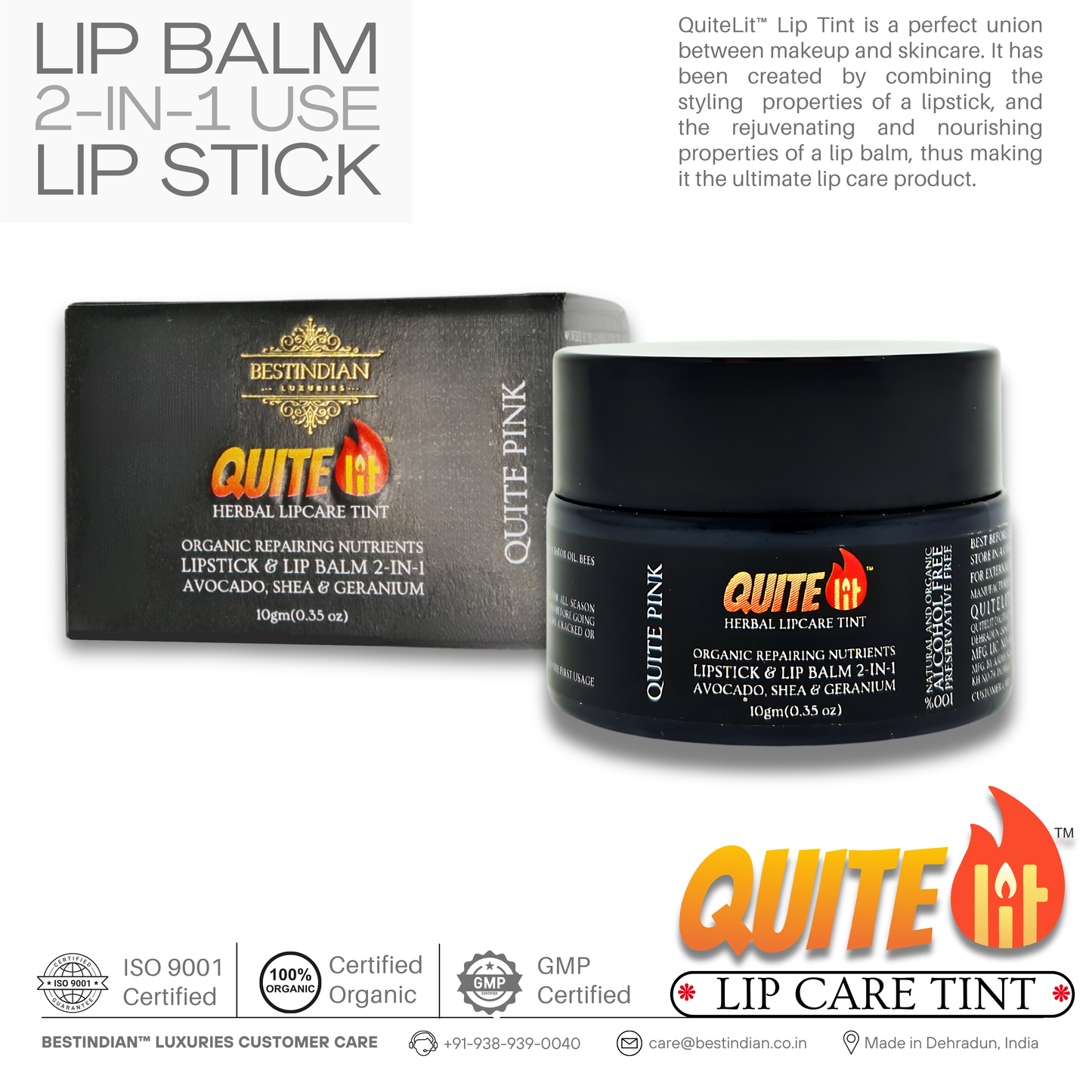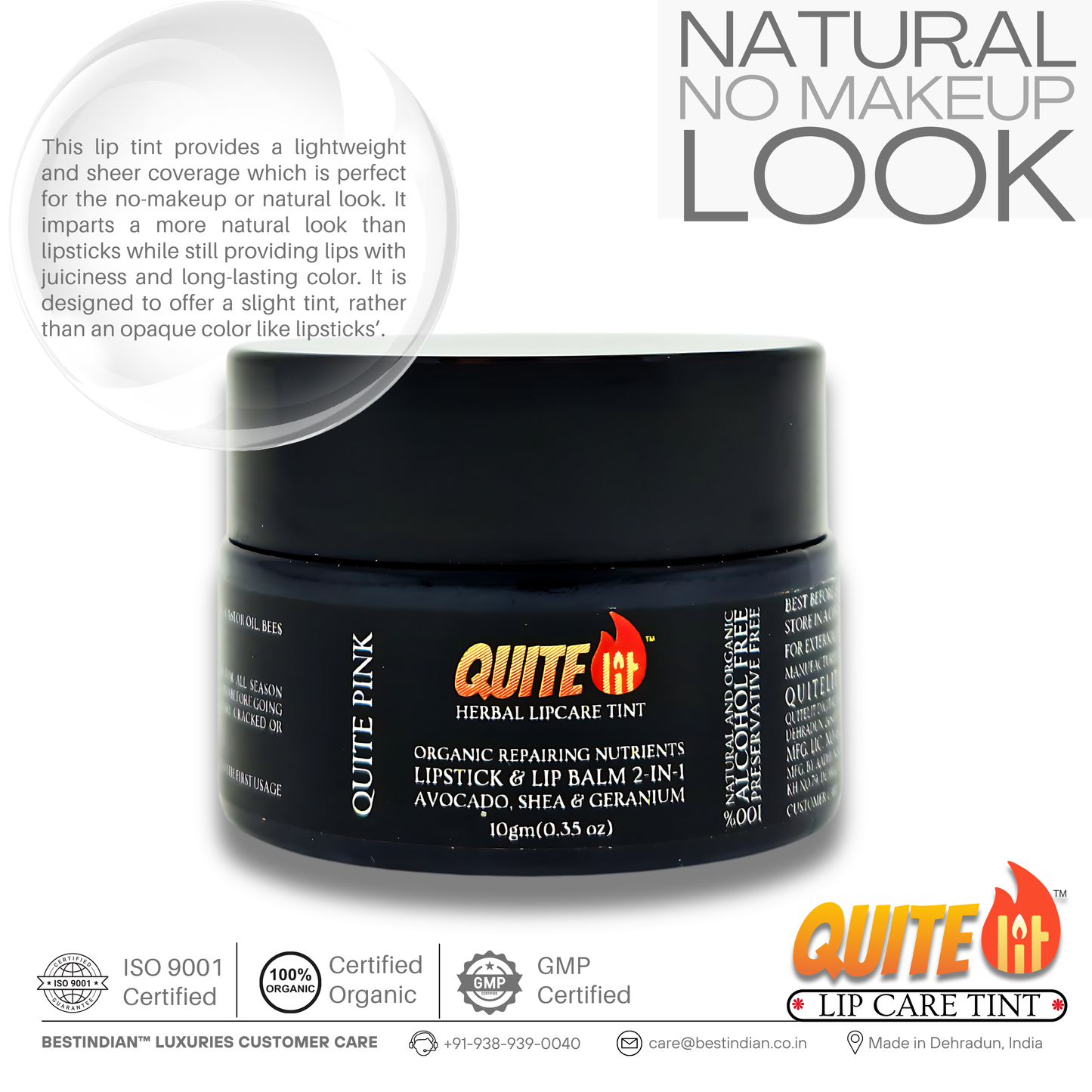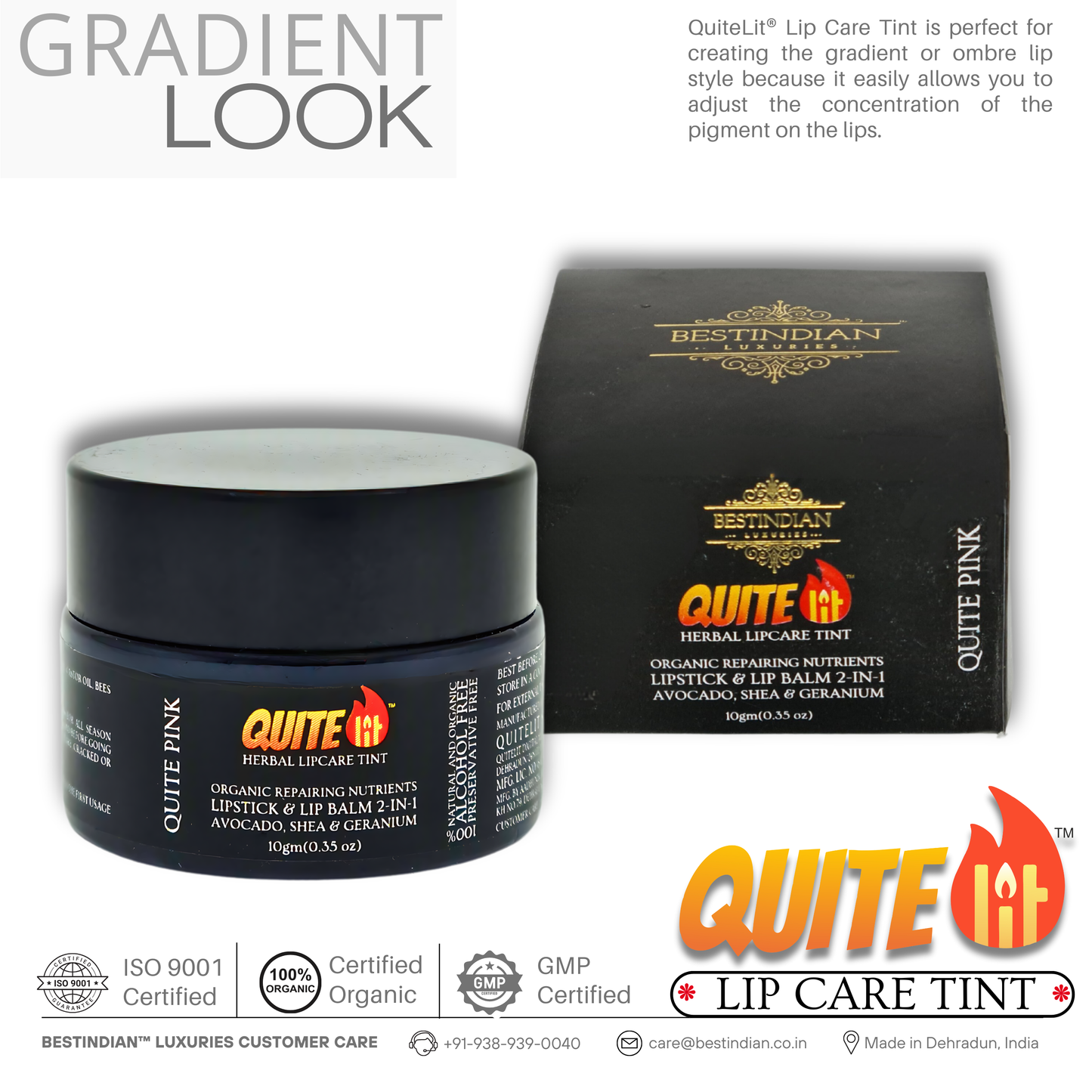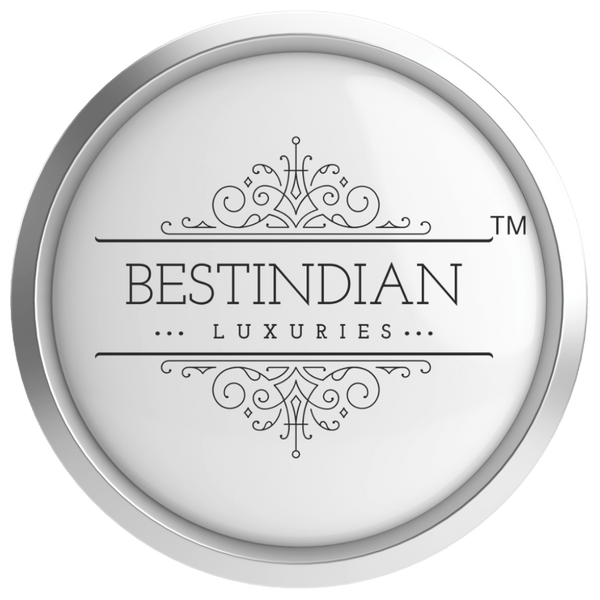BestIndian
QuiteLit™ Lip Tint: 2-in-1 Natural Lip and Cheek Tint
QuiteLit™ Lip Tint: 2-in-1 Natural Lip and Cheek Tint
Couldn't load pickup availability
Tired of choosing between vibrant color and nourished lips, or carrying separate products for your lips and cheeks? Discover the QuiteLit™ Lip & Cheek Tint, a 2-in-1 marvel that fuses makeup with deep skincare. This 100% natural formula is packed with rich Avocado, Shea, and Cocoa butters to provide a long-lasting, buildable flush of color while deeply moisturizing your skin. It's the ultimate natural lip and cheek tint for lightening dark lips, conditioning your pout, and creating a naturally flushed cheek, all from one elegant product.
Your 2-in-1 essential for a natural flush of color that deeply moisturizes lips and cheeks.
100% Natural & Preservative-Free • 2-in-1 Lip & Cheek Formula • Cruelty-Free • Made in Dehradun
Please Note: Conscious Archive Item (60% Off)
- Manufacturing Date: January 2024
- Best Before: January 2026
- This item is part of our Conscious Archive Sale and is offered at an exceptional 60% discount due to its approaching best before date. It is final sale.
Share





















BESTINDIAN LUXURIES
The Finer Details
Why You’ll Love It
Discover effortless beauty with QuiteLit™, a 100% natural lip and cheek tint that doubles as a hydrating balm and a lightweight blush. Crafted with nourishing Avocado, Shea Butter, and Cocoa Butter, this preservative-free tint moisturizes, lightens pigmentation, and delivers a radiant flush of color — perfect for the no-makeup look.
VERSATILE LIP AND CHEEK TINT
⚜️ This is the ultimate multi-tasking essential. It simplifies your makeup routine by providing a beautiful, translucent flush of natural color to both your lips and cheeks, creating a perfectly coordinated and effortlessly radiant look with just one product.
DEEPLY MOISTURIZING LIP TINT
⚜️ Unlike lipsticks that can dry out your lips, this formula is packed with a rich blend of Avocado, Shea, and Cocoa butters. It deeply conditions and hydrates, leaving your lips feeling soft, supple, and comfortable all day long.
LONG-LASTING NATURAL FLUSH
⚜️ Enjoy a juicy, natural-looking color that truly lasts. The buildable formula sets on the skin and is designed not to smudge as easily as traditional lipsticks or glosses, keeping your natural flush looking fresh for hours.
HELPS LIGHTEN DARK LIPS
⚜️ This is makeup that cares for your skin. The 100% natural, nourishing formula works over time to help reduce the appearance of pigmentation, lightening dark lips and restoring their natural, healthy tone.
Why Choose QuiteLit™?
- ⚜️ 2-in-1 Lip & Cheek Tint – versatile color that works beautifully on lips and cheeks.
- ⚜️ Natural & Preservative-Free – made with pure butters and botanicals, free from parabens and chemicals.
- ⚜️ Moisturizes & Repairs – deeply hydrates while protecting lips from dryness and pigmentation.
- ⚜️ Lightweight & Buildable – sheer tint that layers easily, from subtle to bold.
- ⚜️ Long-Lasting & Non-Smudge – stays fresh longer than glosses or lipsticks.
- ⚜️ Perfect for All Skin Tones – creates a natural, radiant glow, ideal for the gradient look or a soft blush flush.
All Benefits
The QuiteLit™ Lip & Cheek Tint is the perfect fusion of vibrant makeup and nourishing care. This 2-in-1 essential delivers the color of a lip tint, the natural flush of a cheek tint, and the hydrating benefits of a balm — your low-maintenance solution for a radiant, effortless look.
⚜️ Benefits of QuiteLit™ – Natural Lip and Cheek Tint
1. Versatile 2-in-1 Color for Lips & Cheeks
⚜️ This multi-purpose natural lip and cheek tint simplifies your routine. It provides a translucent flush of color for cheeks and a juicy tint for lips, giving you a coordinated, sun-kissed glow with one product.
2. Deeply Moisturizes & Nourishes
⚜️ Unlike conventional lipsticks that can cause dryness, this moisturizing lip tint is enriched with Avocado, Shea, and Cocoa Butters. It conditions, hydrates, and protects, leaving lips soft, supple, and healthy all day.
3. Lightens & Brightens Dark Lips
⚜️ More than makeup, it’s care. This lip tint for dark lips helps lighten pigmentation over time, restoring a natural, healthy pink tone while enhancing radiance.
4. Long-Lasting, Buildable & Smudge-Proof
⚜️ A long lasting lip tint designed for wear that stays. Its color is buildable — from sheer natural to bold — and resists smudging better than glosses or lipsticks.
5. 100% Natural & Chemical-Free
⚜️ Made with 100% natural, organic ingredients and free from preservatives, parabens, or synthetics, this natural lip tint is the safest, healthiest choice for your lips and skin.
Discover QuiteLit™ – the best natural lip and cheek tint for buildable, long-lasting color that moisturizes and helps lighten dark lips, all in a preservative-free formula.
Your Ritual & Care
The Application Ritual
This versatile 2-in-1 tint is your key to a quick and effortless wash of natural color. Follow these simple rituals to create your perfect look for any occasion.
For a Natural Lip Tint:
- Start with clean, moist lips for the smoothest application.
- Swipe the tint directly onto your lips.
- Gently blend the color with your fingertip or a lip brush for a soft, natural finish. Touch up once every 6-8 hours to maintain a perfect, fresh look.
For a Bolder or Gradient Lip:
- ⚜️ For a Bolder Look: Simply swipe one or two additional layers to build the pigment to your desired intensity.
- ⚜️ For a Gradient Look: Apply the tint to the center of your lips and then gently blend it outwards towards the edges, leaving the corners softer in color.
For a Natural Cheek Blush:
- Dab a small amount of the tint onto the apples of your cheeks.
- Quickly blend it into the skin using your fingertips or a makeup brush, moving in a circular or upward motion.
- Its unique texture blends seamlessly to create a clear, translucent finish that mimics a naturally flushed cheek.
Ideal For
- ⚜️ Anyone seeking a versatile, multi-purpose lip and cheek tint.
- ⚜️ Those who prefer a minimal, "no-makeup," or natural makeup look.
- ⚜️ Individuals looking for a long lasting lip tint that doesn't smudge easily.
- ⚜️ Anyone wanting to lighten the appearance of dark or pigmented lips with a safe, natural product.
- ⚜️ Makeup lovers who enjoy creating buildable, gradient, or layered looks.
Product Care & Safety
- ⚜️ Store in a cool, dry place away from direct sunlight to preserve the integrity of the 100% natural ingredients.
- ⚜️ For external use only. A patch test on a small area of skin is recommended prior to first usage.
Apply this versatile lip and cheek tint to lips and cheeks, blending with your finger. Layer for a bolder look. Ideal for a long-lasting, natural flush of color.
Complete Your Natural Look
⚜️ Get Glowing with GlowPotion™
Fragrance
A Calming, 100% Natural Geranium Scent
The fragrance of the QuiteLit™ Lip & Cheek Tint is a sophisticated and therapeutic aroma derived entirely from 100% natural Geranium essential oil. It is a refined, calming scent designed to evoke relaxation and help you unwind, completely free from any synthetic chemicals or perfumes.
⚜️ The Scent Profile (Green-Rose & Citrus):
At its heart is a powerful, green-rose note, characteristic of pure Geranium. This is lifted by a bright, citrusy, and slightly minty freshness, and grounded by a subtle hint of earthiness. The result is a beautifully balanced fragrance that is both refreshing and serene, making each application a moment of pure pleasure.
Experience a calming, 100% natural Geranium fragrance featuring a green-rose heart with fresh citrus and minty top notes.
Ingredient Transparency
Our Promise of 100% Transparency
At BestIndian™, we believe you have a right to know exactly what you are putting on your skin. We practice absolute transparency, guaranteeing that no other ingredient, apart from those listed below, has been used in this 100% natural and preservative-free formula. Our commitment is to pure, potent, and honest skincare.
Full Ingredient List (INCI)
Persea Gratissima (Avocado) Butter, Butyrospermum Parkii (Shea) Butter, Theobroma Cacao (Cocoa) Seed Butter, Cocos Nucifera (Coconut) Oil, Ricinus Communis (Castor) Seed Oil, Cera Alba (Beeswax), Pelargonium Graveolens (Geranium) Oil.
Ingredient Deep Dive
The formula for this natural lip and cheek tint is a concentrated blend of nature's richest emollients:
⚜️ Avocado Butter (Persea Gratissima): The Barrier Replenisher
Rich in beneficial lipids and essential fatty acids, Avocado Butter works to replenish the lips’ delicate moisture barrier. It helps to keep them exceptionally soft, hydrated, and protected from environmental stressors.
⚜️ Shea Butter (Butyrospermum Parkii): The Ultimate Soother
A natural emollient celebrated for its high concentration of vitamins and fatty acids. Shea Butter is a superb moisturizer that helps to soothe, soften, and restore suppleness to both lips and cheeks.
⚜️ Cocoa Butter (Theobroma Cacao): The Protective Sealant
This luxurious butter is known for forming a protective barrier over the skin. This breathable seal helps to lock in moisture and prevent water loss, keeping your lips feeling nourished and comfortable for hours.
⚜️ Beeswax (Cera Alba): The Natural Structuring Agent
Beeswax provides the perfect texture and structure for the tint, allowing it to glide on smoothly. It also acts as a natural humectant, attracting moisture to the skin and providing an additional layer of protection.
Formulated Without
Preservatives, Water, Fillers, Parabens, Sulfates, Phthalates, Silicones, and Synthetic Chemicals.
A 100% natural, preservative-free formula featuring Avocado, Shea, and Cocoa butters to deeply moisturize and protect the lips and cheeks.
Frequently Asked Questions
Frequently Asked Questions
1. What is the best natural lip and cheek tint?
⚜️ The QuiteLit™ Lip & Cheek Tint is crafted as the best natural option. With Avocado, Shea, and Cocoa Butters, it delivers beautiful, buildable color while nourishing and protecting lips — 100% preservative-free and chemical-free.
2. How is this different from a lipstick or lip gloss?
⚜️ Lipsticks give opaque color, while a tint creates a sheer-to-buildable, natural wash of color. Unlike gloss, it’s non-sticky and offers a smudge-resistant, long-lasting finish that feels weightless.
3. Will this lip tint dry out my lips?
⚜️ No. This moisturizing lip tint hydrates and conditions with nourishing butters, keeping lips soft, smooth, and supple even with daily use.
4. How long does the color last?
⚜️ Designed as a long lasting lip tint, it sets on lips and cheeks for hours. A light touch-up every 6–8 hours keeps the color fresh and vibrant throughout the day.
5. Can this product help with dark and pigmented lips?
⚜️ Yes. Over time, this lip tint for dark lips helps lighten pigmentation, restoring a natural, healthy pink tone while improving overall lip health.
6. How do I use a lip and cheek tint as a blush?
⚜️ Simply dab a small amount onto the apples of your cheeks and blend with fingertips or a brush. It melts into skin for a seamless, natural flush that looks like your own healthy glow.
7. Is the color buildable?
⚜️ Yes. One swipe gives a sheer, natural look. Add more layers for a bolder, more pigmented effect. Its buildable formula allows complete control over intensity.
8. Is it sticky or heavy?
⚜️ No. The formula is lightweight and comfortable, leaving lips and cheeks with a velvety, natural finish — never sticky or greasy.
9. Is this safe for daily use?
⚜️ Absolutely. This natural lip and cheek tint is free from synthetic chemicals, parabens, and preservatives, making it safe for everyday wear by all skin types.
10. Does it smudge easily?
⚜️ No. Once set, it resists smudging better than lipsticks or glosses, making it a reliable choice for long wear with minimal maintenance.
11. Can men use this tint?
⚜️ Yes. QuiteLit™ is designed for everyone seeking healthy, hydrated lips and a natural tint. Its subtle, buildable finish works well for both men and women.
12. Does this product have SPF protection?
⚜️ Yes. Formulated with natural botanicals, it provides protection against environmental stressors and UV damage, helping to prevent tanning and lip darkening.
13. Is it safe if accidentally ingested?
⚜️ Yes. Made with edible-grade, 100% natural ingredients, it is safe if small amounts are accidentally ingested, unlike synthetic lipsticks with harsh chemicals.
QuiteLit™ – the natural lip and cheek tint that moisturizes, lightens dark lips, resists smudging, and delivers a radiant, long-lasting flush of color for lips and cheeks.
The Science & Sensory Experience
The Science & Sensory Experience
The skin on your lips has a naturally weak barrier, leading to moisture loss. The science of our natural lip tint lies in its anhydrous (water-free) formula. A rich blend of Avocado, Shea, and Cocoa butters acts as a breathable occlusive barrier, helping to prevent moisture loss and lock in hydration. Experience a buttery, lightweight texture that glides on smoothly for a sheer, buildable flush, enveloped in the calming, 100% natural fragrance of green-rose Geranium.
The Science of Lip Health & Beauty
The skin on the lips is a unique and delicate structure, with a very thin outer layer (stratum corneum) that gives it a naturally poor barrier function. This makes it highly susceptible to moisture loss and environmental damage. The science behind the best natural lip and cheek tint is rooted in creating a formula that both protects this vulnerable barrier and delivers beautiful, healthy color.
⚜️ The Challenge: A Compromised Lip Barrier & Moisture Loss
Due to their unique anatomy, lips have a high rate of Transepidermal Water Loss (TEWL), which leads to dryness, chapping, and a loss of fullness. Environmental factors like sun, wind, and temperature extremes, along with age-related degeneration of collagen and elastic fibers, further compromise this delicate barrier.
⚜️ The Scientific Solution: A Nourishing Occlusive & Emollient Barrier
Our 100% natural, anhydrous (water-free) formula is rich in a blend of botanical butters (Avocado, Shea, Cocoa) and Beeswax. This creates a multi-functional lipid layer that acts in two ways: as an occlusive, it forms a breathable barrier to significantly reduce TEWL and protect from the environment; and as an emollient, its rich fatty acid content deeply soothes, softens, and restores suppleness to the lips.
⚜️ The Challenge: Delivering Color Without Dryness
The goal of a lip product is to provide beautiful color, but many conventional formulas can be drying, cakey, or accentuate fine lines (lip furrows). An ideal formula must deliver long-lasting color while simultaneously conditioning and improving the lip's texture.
⚜️ The Scientific Solution: Dual-Action Color in a Conditioning Matrix
Our natural lip and cheek tint uses a dual-action approach to color. It contains natural colorants that provide a long-lasting stain while also depositing a layer of color on the surface for a smooth, uniform appearance. Crucially, this color is delivered within a rich, nourishing matrix of butters and oils. This ensures that as you apply color, you are also delivering essential fatty acids and vitamins that hydrate, condition, and improve the appearance of lip texture.
The science behind our natural lip and cheek tint involves using a rich, occlusive barrier of natural butters to prevent moisture loss, while a dual-action color system delivers a long-lasting stain within a deeply conditioning, non-drying formula.
Star Ingredients
-

Avocado
Avocado (Persea Gratissima) contains lipids which replenish lips’ natural moisture barrier to keep them soft and hydrated .The omega 3+6 essential fatty acids boost the lips' natural process of moisture regulation, helping to soothe, soften and restore suppleness.
-

Shea Butter
(Butyrospermum Parkii) — A natural emollient packed with vitamins and fatty acids that deeply soothes, softens, and restores suppleness to both lips and cheeks. The main component of Shea butter is triglycerides that have oleic, linoleic,
stearic and palmitic fatty acids in addition to some unsaponifed matter such as tocopherol, sterols and phenols. -

Geranium
Geranium, a genus of annual, biennial, and perennial plants; contains complex phytochemicals, produced as secondary metabolites, such as terpenes, esters, aldehydes, ketones, alcohols, and phenols. It is a cicatrisant, and an astringent in nature.

Trust & Transparency
The BestIndian™ Promise
At BestIndian™, we believe luxury is defined by authenticity & efficacy. Our philosophy marries the timeless wisdom of Ayurveda with the precision of modern science. We disclose all ingredients used in every product we make, because your trust is our most valued asset.
⚜️
Our Promise: Formulated with 100% natural and certified organic ingredients. Always free from preservatives, parabens, and sulfates. Vegetarian and vegan friendly. No hidden ingredients.
⚜️
Our Certifications: Manufactured in a GMP, ISO & COSMOS Organic certified, carbon-neutral, cruelty-free facility amidst pollution-free environment of the Himalayas in Dehradun, India
OUR BRANDS
-

Moviestar™ – Luxury Ayurvedic Skincare brand by BestIndian™
Luxury skincare designed for professional actors. Moviestar™ by BestIndian™ is a premium...
-

GlowPotion™ – Natural Ayurvedic Skincare brand by BestIndian™
The pinnacle of beauty is a complexion that requires no makeup to...
-

The Elixir of Youth™ Collection for Anti-Aging & Wrinkle Repair
Welcome to Elixir of Youth™- scientifically created, high-performance Ayurvedic formulations designed by...



























